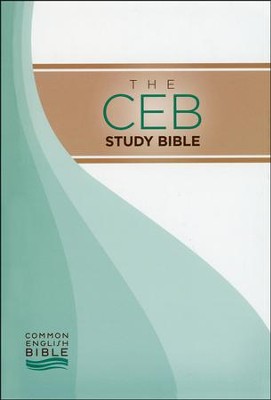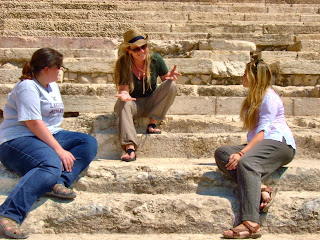The CEB Study Bible: A Brief Review
Some time back I received a copy of the Common English Bible (CEB) Study Bible. I have had the pleasure of owning many study Bibles like the NLT, ESV, NAB, NIV, NRSV, and they all have their strengths and weaknesses. The CEB may not contain some of the bells and whistles that some of the others do, but what it lacks in flash, it more than makes up for in content.
First, the CEB Study Bible utilizes the services of sixty-two contributors. This number reflects the edition that contains the Apocrypha, another unique feature that is absent in many of the ones I listed above (e.g. NLT, ESV, NIV). As expected, many of the names are very recognizable in the field of biblical studies, but what impressed me more were the names that were not as recognizable. This shows the editorship, lead by Joel Green, did their homework, finding and giving opportunities to a diverse array of scholars whom they felt were deserving to have their voices heard.
Not unique to the CEB, but a feature that was well conceived and executed were the various sidebar articles that get more extensive treatment than the study notes proper. By my count, (I had the edition that contained the Old & New Testaments) 253 sidebar articles appear, spread across 66 canonical books, or nearly four sidebars per book. So, for instance, the bizarre image of the four living creatures of Ezekiel 1:5ff. has a sidebar article called "The Living Creatures." John T. Strong, author of the Ezekiel study notes, provides some helpful information about various archaeological evidence that depicted similar imagery of a god enthroned, surrounded by creatures, giving the reader helpful context in what or whom this imagery represents (1319, OT).
My favorite area of study currently is the Gospel of John, and I was delighted to see one of my favorite scholars, J. Ramsey Michaels, author of the magisterial commentary by the same name in the NICNT series, as the author of the study notes. In fact, one can say that Michaels' contribution is a bite-size version (pp. 167-213, NT) of his massive NICNT contribution (1,094 pp.). Ramsey's introduction is brief and to the point (167-168), covering authorship, differences and similarities to the Synoptics, unique features of the Fourth Gospel, highlighting distinctive Johannine stylistic themes that appear repeatedly throughout the narrative. An outline, identical to the one contained in his commentary is featured, marked by Ramsey's unique emphasis on the "Preamble" (1:1-5) within the Prologue (1:1-18). Included in these notes is a wonderful sidebar, "The Stoning That Doesn't Happen" (187, NT). This sidebar is the bracketed episode of the woman caught in adultery (7:53-8:11). Many are aware that this episode does not appear in the earliest manuscripts, but has been retained, albeit in brackets, by the CEB. What makes Ramsey's article interesting, much like his comments in his commentary, is he discusses what the episode contributes by keeping it in the narrative, as well as how the narrative reads without the episode.
Much more could and should be said about the CEB Study Bible. Along with the NRSV Study Bible, it is now first off my shelf for consulting and reading. There is a wealth of information in these pages, and the editors deserve a hearty, "Congratulations" on a job well done.
First, the CEB Study Bible utilizes the services of sixty-two contributors. This number reflects the edition that contains the Apocrypha, another unique feature that is absent in many of the ones I listed above (e.g. NLT, ESV, NIV). As expected, many of the names are very recognizable in the field of biblical studies, but what impressed me more were the names that were not as recognizable. This shows the editorship, lead by Joel Green, did their homework, finding and giving opportunities to a diverse array of scholars whom they felt were deserving to have their voices heard.
Not unique to the CEB, but a feature that was well conceived and executed were the various sidebar articles that get more extensive treatment than the study notes proper. By my count, (I had the edition that contained the Old & New Testaments) 253 sidebar articles appear, spread across 66 canonical books, or nearly four sidebars per book. So, for instance, the bizarre image of the four living creatures of Ezekiel 1:5ff. has a sidebar article called "The Living Creatures." John T. Strong, author of the Ezekiel study notes, provides some helpful information about various archaeological evidence that depicted similar imagery of a god enthroned, surrounded by creatures, giving the reader helpful context in what or whom this imagery represents (1319, OT).
My favorite area of study currently is the Gospel of John, and I was delighted to see one of my favorite scholars, J. Ramsey Michaels, author of the magisterial commentary by the same name in the NICNT series, as the author of the study notes. In fact, one can say that Michaels' contribution is a bite-size version (pp. 167-213, NT) of his massive NICNT contribution (1,094 pp.). Ramsey's introduction is brief and to the point (167-168), covering authorship, differences and similarities to the Synoptics, unique features of the Fourth Gospel, highlighting distinctive Johannine stylistic themes that appear repeatedly throughout the narrative. An outline, identical to the one contained in his commentary is featured, marked by Ramsey's unique emphasis on the "Preamble" (1:1-5) within the Prologue (1:1-18). Included in these notes is a wonderful sidebar, "The Stoning That Doesn't Happen" (187, NT). This sidebar is the bracketed episode of the woman caught in adultery (7:53-8:11). Many are aware that this episode does not appear in the earliest manuscripts, but has been retained, albeit in brackets, by the CEB. What makes Ramsey's article interesting, much like his comments in his commentary, is he discusses what the episode contributes by keeping it in the narrative, as well as how the narrative reads without the episode.
Much more could and should be said about the CEB Study Bible. Along with the NRSV Study Bible, it is now first off my shelf for consulting and reading. There is a wealth of information in these pages, and the editors deserve a hearty, "Congratulations" on a job well done.


Comments